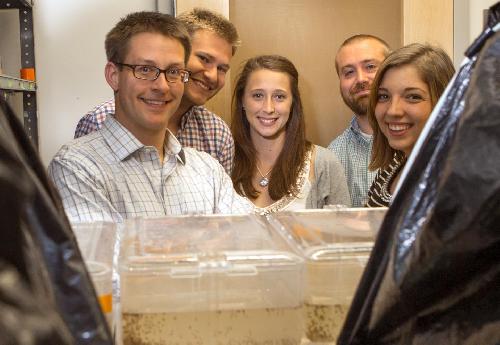The very thought of them makes a person shudder - and scratch. Those bloodsucking bed bugs are endemic in every major city, and they're very hard to get rid of. A massive international research partnership - including the University of Cincinnati - has sequenced the entire genome of the common bed bug, uncovering several traits that also could reveal why they're so resistant to pesticides. The article is one of two papers sequencing the bed bug gene that is published this month in the journal, Nature Communications.
The intensive analysis of the common bed bug (C. lectularius) sequenced genome (650 Mb) and 14,220 predicted protein-coding genes. The investigation provides a comprehensive representation of genes linked to the bed bugs' mating traits (traumatic insemination). The examination also reveals a reduced chemosensory repertoire of genes related to making them the little blood suckers that they are, as well as several qualities that can make them resistant to pesticides. "We provide the first full panel of all the potential genes that are likely involved with pesticide resistance," says lead author Joshua Benoit, a UC assistant professor of biological sciences.
The massive analyses involved rearing the bed bugs, extracting DNA and sequencing and assembling the genome. The report provides a full annotation of genes that compose the bed bug cuticle, or their outer skeleton. That tough outer shell plays a significant role in their resistance to pesticides. It's believed that resistance is a result of changes in the expression of cuticle proteins. The researchers identified 273 genes that encode common cuticle proteins.
 UC research team from left are: Joshua Benoit, Jake Hendershot, Elise Szuter, Andrew Rosendale, Emily Jennings. Credit: Joseph Fuqua II
UC research team from left are: Joshua Benoit, Jake Hendershot, Elise Szuter, Andrew Rosendale, Emily Jennings. Credit: Joseph Fuqua II
"We found underlying characteristics surrounding why they feed off only blood," says Benoit, who adds that the bed bug can survive an entire year without a meal. In other words, if someone's home is infested and that person leaves the premises for a few weeks in the hope that the bed bugs will go away, that isn't going to happen. The bed bugs will be hungry and waiting when the "host" gets back home.
The genome examination revealed what chemical cues attract the bed bug and genes associated with blood digestion.
The profile also found the gene related to how bed bugs mate, which is through what's called traumatic insemination. The male pierces an area in the female that is not a reproductive organ, yet she will develop a new, auxiliary reproductive organ to accommodate that form of reproduction.
"They seem to be uniquely central to lateral gene transfers from bacteria," adds Benoit. "We picked up more than 800 putative lateral gene transfer bits." That included Wolbachia bacteria, a common reproductive parasite, and Arsenophonus.
"Parts of the genome from this bacteria have been inserted into the bed bug genome," explains Benoit. "This happens once or twice in a lot of incidences, but having it happen a hundred times is unique. And one specific gene is even expressed."
International research institutions on this project represent the U.S., India, Germany, Switzerland, France, Taiwan, New Zealand and the United Kingdom.
"This study reveals evolutionary adaptations associated with the lifestyle of bed bugs, including significant reductions in chemosensory genes, expansion of genes that are associated with blood digestion, and the entire repertoire of genes that have been associated with pesticide resistance in various other species. The sequencing, assembly, annotation and manual analyses of the C. lectularius genome provide an important and timely resource for understanding the biology of this human ectoparasite. It will also serve as a gateway for the discovery of new targets for control of bed bug populations," concludes the paper.
source: University of Cincinnati